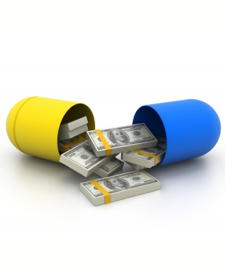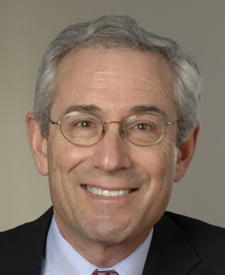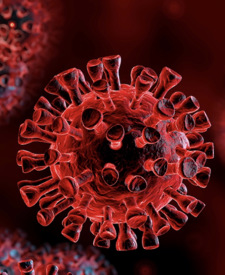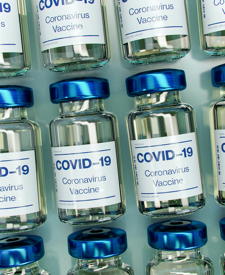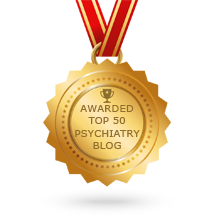September 10th, 2022
I wondered whether to recommend Nuedexta for my elderly relative with worsening Alzheimer’s disease and daily spontaneous crying. Often she would deny feeling sad and couldn’t account for her sobbing. Avanir Pharmaceuticals released Nuedexta in 2010 to treat pseudobulbar affect: involuntary emotional outbursts due to certain neurologic conditions or brain injury. I wasn’t sure if these crying bouts qualified as pseudobulbar affect. But my biggest hesitation was the breathtaking price of the drug.
Nuedexta is a “fixed-dose combination” (FDC) medication containing dextromethorphan (DXM) and quinidine. The former is an active ingredient in over-the-counter cough syrup, the latter a century-old antiarrhythmia medication. Both are very inexpensive, and DXM doesn’t even require a prescription. Yet according to GoodRx, the average retail price of Nuedexta is nearly $1700 per month. There’s no generic equivalent yet, although there may be soon.
It’s impossible to comparison-shop for novel prescription drugs like Nuedexta. Patent protection and “non-patent exclusivities” enforce monopolies: no company can sell the same product generically or under another brand name for 20 years after a drug is invented, or about ten years after it hits the marketplace. Justified as a way to recoup development costs, pharmaceutical companies often manipulate these price protections to maximize profits.
1. How to win at Monopoly: Mix it up
One way is to create a new, pricey FDC medication, like Nuedexta, out of two or more cheap generics. To take another example, the FDA approved Auvelity last month to treat major depression. It’s an FDC that combines DXM — the very same cough suppressant — with bupropion, a common generic antidepressant. Auvelity reportedly works faster than conventional antidepressants. The manufacturer has not yet announced a price, but it’s safe to assume it will be far higher than that of its generic components.
This isn’t a new practice. Triavil (1962) combines the antidepressant amitriptyline and the antipsychotic perphenazine. Adderall (1996) combines several generic amphetamines. Symbyax (2003) mixes the antidepressant fluoxetine with the antipsychotic olanzapine — an updated Triavil, in a way.
Outside of psychiatry, it’s easier to justify some FDC formulations. Oral contraceptives combine two hormones, estrogen and progestin. Antiretroviral FDC drugs revolutionized AIDS treatment. The novel FDC Paxlovid uniquely benefits COVID-19 patients.
2. How to win at Monopoly: Find a new use
Another way to game the system is to obtain FDA approval to market an old medication for a new use. It’s the same drug with a fancy new name, packaging, and price. Its new use may not even be particularly novel: it may be for a condition that doctors already treated with the generic drug “off label.”
For example, doxepin has been around since 1969 as an antidepressant. Long available as an inexpensive generic in capsules of 10 to 150 mg, it’s never been popular because it’s too sedating. In fact, doctors occasionally prescribed it “off label” for insomnia, not depression. Turning a bug into a feature, in 2010 Currax Pharmaceuticals rebranded doxepin in low-dose 3 and 6 mg tablets as the patent-protected, FDA-approved sleeping aid Silenor.
According to GoodRx, the average retail price of Silenor is over $600 per month. There was no direct competition until 2020, although generic doxepin remained available. Of course, it’s hard to split a 10 mg capsule at home to make a 3 or 6 mg dose for insomnia. Now with generic competition — about 1/4 the price of the brand name, but still many times more expensive than the larger capsules — Currax strongly urges everyone to insist on brand-name Silenor.
This is hardly a lone case. GlaxoSmithKline patented and released Zyban (1997) for smoking cessation to extend its monopolistic pricing for sustained-release bupropion. Zyban is exactly the same medication, at the same dosage, that was losing its patent protection as the antidepressant Wellbutrin SR. Eli Lilly likewise patented and released Sarafem (2000) for premenstrual symptoms to extend its monopolistic pricing for fluoxetine. Sarafem is exactly the same medication that was losing its patent protection as the antidepressant Prozac.
3. How to win at Monopoly: Tweak it
A third and very common way to extend monopolistic pricing is to tweak an existing medication just enough to justify a new patent. Lexapro (2002) supplanted the older Celexa, even though both are citalopram. The difference is chemically arcane: Lexapro is the S-enantiomer, perhaps with fewer side effects compared to the racemic compound in Celexa. Pristiq (2008) contains desvenlafaxine, an active metabolite that is arguably a minor improvement over venlafaxine in the older Effexor. Lybalvi (2021) combines generic olanzapine with a new medication samidorphan to decrease some of olanzapine’s side effects.
Do these updates justify the premium cost of the brand names (while they are still patent-protected) over the generics? That’s a judgment call — not in my opinion, although many of my colleagues think so.
People or profit?
It’s clear that many new drugs mainly serve business interests, not health care. A visiting Martian might ask: Why didn’t the FDA simply announce that generic bupropion helps with smoking cessation, and generic fluoxetine with PMS? Why didn’t the FDA have doctors tell patients to take non-prescription DXM with their prescription bupropion for depression? Or take it with prescription quinidine to treat pseudobulbar affect? Why didn’t the FDA advise manufacturers to make generic doxepin in smaller dosages?
We Earthlings know why. If the federal government conducted its own product research, it could make these recommendations to improve public health, not to maximize profit. Instead, on this planet, profit drives drug development. Indeed, when a clearly needed medication is unprofitable for private enterprise, the government steps in and pays a company to develop the “orphan drug.” It’s a clear illustration that business goals and health needs aren’t the same.
My relative with dementia took Nuedexta for a couple of weeks. It had no effect and was discontinued, leaving about $800 worth unused. In her case, no one went broke helping Avanir recoup its investment. Other families are not so fortunate.
More recently I evaluated a patient with chronic depression. Over many years she’d tried nearly every class of antidepressant several times, as well as various antidepressant “augmenting” medications and mood stabilizers (and, yes, psychotherapy). As luck would have it, she’s currently taking maximum doses of bupropion. Before sending her off for more esoteric treatment, I suggested she add cough syrup containing DXM, 20 mg per day, and call me back in ten days. Auvelity isn’t available yet — not that I’d be inclined to prescribe it even if it were.
Image courtesy of ddpavumba at FreeDigitalPhotos.net
August 7th, 2022
When one of America’s most prominent psychiatrists expresses deep disdain for depth psychotherapy, especially when that criticism is misinformed and hopelessly outdated, it should concern all of us.
Dr. Tom Insel directed the National Institute for Mental Health (NIMH) from 2002 to 2015. Formerly a psychiatric researcher “at the cellular level,” he studied medications and neuroscience. Insel admits that under his directorship the NIMH didn’t improve care for those with serious mental illness (SMI):
I spent 13 years at NIMH really pushing on the neuroscience and genetics of mental disorders, and when I look back on that I realize that while I think I succeeded at getting lots of really cool papers published by cool scientists at fairly large costs—I think $20 billion—I don’t think we moved the needle in reducing suicide, reducing hospitalizations, improving recovery for the tens of millions of people who have mental illness.
After NIMH, Insel led the mental health initiative at Verily, the Google-spawned health science company; co-founded Mindstrong Health, a digital mental health company focused on SMI; launched Humanist Care, a recovery-oriented online therapeutic community; and served as “behavioral health czar” to Governor Gavin Newsom of California.
Even at age 70, Insel apparently hasn’t found a comfortable place to settle down. But having learned a thing or two, he wants everyone to know. Thus his book Healing: Our Path From Mental Illness to Mental Health (Penguin Random House, 2022).
The book’s main message is that we can already help most people with SMI. We “merely” lack the social and political will to make it happen. He grossly downplays these social and political challenges, offering only a roadmap, not policy proposals.
The roadmap, though, is fundamentally sound: comprehensive biopsychosocial care. In other words, the biological treatments Insel knows so well, plus skills training, peer and family support, therapeutic communities, a shift from incarceration to treatment, and so forth. It’s all perfectly sensible, if unsurprising.
Unfortunately, there’s a glaring bias in Insel’s narrative. Throughout the book, and confirmed in a recent interview with the New York Times’ Ezra Klein, Insel repeatedly denigrates psychoanalysis, psychodynamic therapy, and all psychotherapy that is not symptom-focused or “skills based.”
Insel claims such therapies are “eminence-based care” in contrast to “evidence based” [pg 103], and that psychoanalysis is “not by itself a treatment for mental illness” [pg 51]. He believes that traditional psychotherapy blames parents and families for mental illness, and that only by discarding these outmoded approaches, families can now be part of a patient’s support team. He derides analytic therapy as dwelling on childhood, not current life. By contrast, according to Insel, evidence-based therapy focuses on learning skills:
That’s not what you get with talk therapy that’s not focused. It doesn’t have an evidence base. So I’m a huge proponent of psychotherapy, but it has to be psychotherapy that actually involves those kind of skills learning that has a kind of scientific basis to it with people trained to do it in the way that works.
In his book Insel falsely claims that Victor Frankl developed logotherapy, a type of existential psychotherapy, in reaction “to the introspection and self-absorption of psychoanalysis” [pg 174]. (Logotherapy aims to be more positive than Freudian analysis, not less introspective.) Writing about ELIZA, an early computer program designed to (roughly) mimic client-centered Rogerian therapy, Insel treats ELIZA’s simple algorithmic responses as though they accurately reflected Carl Rogers himself: “Of course, the Rogerian therapist, with this obnoxious reflexive response, was hardly better than a robot and certainly an easy form of ‘natural language’ to automate” [pg 204]. In rushing to condemn such therapy, Insel conflates a primitive computer program with a real therapist who was neither obnoxious nor reflexive.
Finally, Insel praises Woebot, a chatbot that provides a version of CBT. He quotes Woebot (actually, its programmers), apparently sharing their sneering disdain for the “couches” and “childhood stuff” of traditional Freudian analysis, as well as their updated vision of therapy larded with strategies and jokes:
I’m here for you 24/7. No couches, no meds, no childhood stuff. Just strategies to improve your mood. And the occasional dorky joke. [pg 215]
There’s a lot to look at here. First, mental illness, including SMI, is very heterogenous. Schizophrenia, bipolar disorder, and OCD count, but by Insel’s reckoning, so do major depression, PTSD, and borderline personality disorder. This broad category of SMI obscures a wide variation in the applicability of various psychotherapies.
Most psychiatrists (but not all) agree there is little direct role for insight-oriented, depth psychotherapy in the treatment of schizophrenia, bipolar disorder, or OCD. Nonetheless, even in these conditions, therapies of “depth, insight, and relationship” can help a sufferer come to terms with his or her debilitating condition, reflect on issues of self-identity and life’s meaning, improve treatment adherence, and provide emotional support. In other words, even when such therapy doesn’t treat the problem itself, it can help the patient deal with feelings about the problem. The relationship can be stabilizing and very valuable.
It’s a far different matter when it comes to depression, PTSD, borderline personality, and many other potentially devastating conditions. Here we see much stronger evidence for the benefits of in-depth psychotherapy. Insel is plainly mistaken when he implies that such psychotherapy lacks the evidence of efficacy that other therapies have:
… for many issues (e.g., depression, anxiety, eating disorders, PTSD) there are specific therapies that have been validated empirically — sometimes called empirically supported treatments. [pg 252]
It is a widely-held but false belief that only symptom-focused psychotherapy, usually cognitive behavioral in nature and sometimes manualized or algorithmic, is evidence based. Insel should know better. There is a large evidence base for analytic, depth therapies, particularly for depression and anxiety. Consequently, he is also mistaken when he declares these therapies are not by themselves “a treatment for mental illness.” They clearly are.
Perhaps worse are the outdated stereotypes he uses to denigrate such therapy. Yes, many decades ago psychoanalysts blamed “refrigerator mothers” for autism and “schizophrenogenic” mothers for schizophrenia. Dismissing current analytic practice for these old errors is just as silly as dismissing modern biological psychiatry for previously using lobotomy.
Contemporary analytic therapy doesn’t blame parents or anyone else, nor is it trapped in endless rehashing of childhood. It tackles plenty of present-day, pragmatic concerns. But it does so while revealing underlying thoughts, wishes, fears, and more complex emotions, and while closely attending to the relationships the patient forms with the therapist and others. Like everything else, psychoanalysis has evolved in the past 50 years since Insel experienced it. Since he’s an influential speaker and writer, it would be good if his prejudices evolved too.
By far the most ironic twist is Insel’s newfound emphasis on the importance of people (“people, place, and purpose”) and especially relationships for recovery from SMI. This was his big insight in moving from a strictly biomedical view at NIMH. While peer groups and clubhouses certainly provide support, the healing value of a close relationship with a caring therapist has been well known for at least a century. The therapists Insel belittles have certainly known it all along. His ultimate hypocrisy is complaining about, and failing to take responsibility for, the woeful dearth of research in this area:
But social connection is not simply the absence of loneliness. Connection, experienced as support, attachment, or love, has a power that has not been studied sufficiently. [pg 163]
Why hasn’t this power been studied sufficiently? Surely, one guilty party is the former director of our premier mental health research agency, the NIMH. The power of connection, experienced as support, attachment, or love, may very well “move the needle in reducing suicide, reducing hospitalizations, [and] improving recovery.” Finding out probably won’t cost anywhere near $20 billion, yet it still awaits serious attention by NIMH.
Page numbers refer to Insel T, Healing: Our Path From Mental Illness to Mental Health, Penguin Random House, 2022, Kindle version. Quotations without page numbers are from the New York Times interview transcript.
February 7th, 2022
To be heard over today’s cacophony of voices, one needs a hook: a meme, a viral photo, a catchy phrase, a juicy zinger, a sound bite. Speakers soon learn that overstimulated, desensitized attention spans require more and more goosing. Some call this the attention economy feeding our dopamine addiction. To others it has a simpler name: hype.
Jessica Bennett presents the problem very cogently in a recent New York Times guest essay. She focuses on a particular strategy: hyping all setbacks or frustrations as “trauma,” and hyping every offense as “abuse” or “gaslighting.”
It’s an excellent essay and certainly worth reading. But the phenomenon goes well beyond Bennett’s many examples of clinical terms that pathologize the actions of others.
Poisoning the well
Pathologizing the others themselves has an even longer history. For one thing, it led to the 1973 Goldwater Rule, which (still) forbids members of the American Psychiatric Association from offering psychiatric opinions about public figures. The APA created this rule because in 1964 a provocateur magazine publisher persuaded nearly 1200 American psychiatrists to wield psychiatric concepts as weapons to attack presidential candidate Barry Goldwater.
According to these doctors, Senator Goldwater didn’t merely hold offensive political views. He was “schizophrenic,” a “megalomaniac,” and plenty of other bad names casually borrowed from the professional literature. Since this flood of pseudoscience reflected more poorly on the psychiatrists than on Goldwater himself — Goldwater won a defamation lawsuit against the publisher — the APA established the rule to save its members from further embarrassing themselves and their profession.
A tool (that seemed) too handy to set aside
Few challenged this prohibition in the 42 years before Donald Trump’s presidential run. Then it suddenly became important among certain mental health professionals not merely to slam Trump’s politics, values, and attitudes, but to declare them the product of a sick mind.
Alleging psychopathology, especially by credentialed experts, often proves a more powerful weapon than simple disagreement. In this case, however, it wasn’t powerful at all. Preaching to the choir about Trump’s mental ills merely invited counter-pathologizing of Trump’s opponents — clearly not what these authors had in mind.
Of course, amplifying disapproval by adding psych jargon doesn’t require a mental health professional. (Nor is such jargon always, or mainly, critical. Therapy-speak is rampant for all kinds of reasons.) Historically, evildoers have been “monsters” — the word originally meant an infant born with birth defects, believe it or not — or “madmen.” Now reprehensible people are “narcissists” or “sociopaths,” especially on social media. They “gaslight,” “abuse,” and “love-bomb” the innocent. As Bennett writes, it’s a lot more powerful to call someone an abuser than to admit they hurt your feelings.
Winning by losing
A few years ago I wrote about “onedownmanship” — oneupmanship in reverse — as a method to win arguments by positioning oneself as the more victimized party. Just as social media algorithms guide users to more and more extreme content, our victimization “race to the bottom” rewards greater hurt with greater attention and legitimacy.
Saying this risks blaming the victim. Indeed, many commenters assailed my post where I held that “psychopath” often serves as a vague epithet of disapproval. They said my view was “gaslighting,” and at least one suggested I might be a psychopath myself. (Psychology Today has since removed comments from all posts.) In other words, unhappy commenters employed popular pathologizing terms to discredit me for failing to honor the terms of their victimhood.
I do not mean to blame victims. Nor do I believe rhetorical misuse of psych jargon is premeditated or intentionally manipulative. I’m sure it feels self-justifying. And it simply works as a way to get one’s point across, to be heard above the din. That’s why people use it.
Why not use psych jargon as hype?
Nonetheless, drawbacks abound. Pathologizing others in public discourse is essentially an ad hominem argument, a logical fallacy. Popular terms such as “abuser” (and “racist” and “snowflake”) are personal putdowns, not valid arguments.
Psychiatric labels compound the problem by linking destructive stereotypes to named disorders. Whether Donald Trump is a malignant narcissist matters less than continual cultural reminders that narcissists are dangerous, “toxic” people we need to beware and avoid.
Using psych jargon as hype also cheapens these otherwise useful terms (see “trauma creep”). If everyone who feels down or disappointed is “depressed,” how do we describe those who ponder suicide all day and haven’t showered in weeks? If a bad date is “traumatic,” what term do we use when someone is critically injured in a terrorist attack?
Don’t hate the player, hate the game
In a noisy restaurant (remember those?) everyone speaks louder to be heard. Yet this adds to the noise that all must speak over — a vicious cycle. The cacophony is no one’s fault, but everyone’s doing. Likewise, if it takes psych jargon and similar hype to attract an empathic public, can we blame those who use it? We can’t. The hype is no one’s fault, but everyone’s doing.
Fortunately, both situations eventually self-correct. Diners learn that a noisy restaurant is not a good place for serious conversation. They go elsewhere for earnest talk, and as a side-effect they stop feeding the vicious cycle. In like fashion, eventually we’ll realize that overstated language conveys less information, not more.
Hype, of the psych-speak variety and otherwise, will one day strike us as florid, perhaps foppish, and in any case less compelling. It will self-correct. We can hasten that day by noting when rhetoric is inflated for effect. Is frustration or disappointment really “trauma?” Is an isolated act of disrespect “abuse?” Does all misbehavior reflect a psychiatric condition? Only if we say so.
Photo by Verena Yunita Yapi on Unsplash
August 8th, 2021
A natural experiment
Which is better: psychotherapy using video, or in person while wearing masks?
At the very start of the pandemic last year, I met with a couple of patients in the office while we wore masks. Based on that limited experience, I quickly concluded that seeing each other’s faces, even if over video, was of paramount importance. That, plus the infection risk, led me to close my office to in-person appointments. For more than a year I exclusively conducted my practice by video (mostly) and over the phone (occasionally). Even though phone calls preclude seeing faces, they seemed no worse in that respect than a masked office visit.
A few months ago I reopened my office to vaccinated patients, and saw them without masks. Most of those who were eligible returned to the office; a minority did not. I didn’t conduct a survey, but it seemed clear that those who remained online did so for practical reasons, i.e., time or distance, not because they felt it was more clinically beneficial.
For me, meeting again with patients in the office felt like the good old days. I sometimes joked that it was “3-D,” not on a screen. Indeed, I was occasionally struck by how much “presence in the room” mattered. Being with another person in the same space is a different experience. Among other things, it connotes intimacy and privacy. My hybrid (in person and online) practice persisted out of necessity — not because the options were interchangeable.
Unfortunately, the coronavirus Delta variant recently added another twist. Just this past week, San Francisco and surrounding counties mandated indoor masking in public places, for the vaccinated and unvaccinated alike.
I support this new public health law, which aims not only to protect the unvaccinated from severe disease and death, but also to decrease asymptomatic spread by everyone. This, in turn, decreases the risk of new, perhaps more deadly variants. So this past week my in-person sessions have been masked. These switches — from a year of video, to a few months of in-person unmasked, and now to in-person masked — create a natural experiment, allowing my patients and me to compare these situations.
Face to face is better, even masked
Somewhat to my surprise, and in contrast to my quick impression back in March 2020, I find masked, in-person encounters more engaging, real, and human than the video alternative. Even with masks, it is still “3-D.” There are no technical glitches. We are still in a room together. I also asked those who came to the office whether, given the masks, they’d rather return to video. The results were nearly unanimous: they preferred meeting in person with masks to mask-free video sessions.
The only possible exceptions were two patients who refused to don masks last week despite the new law, and despite my advising them to do so. (I wore one but they didn’t. I didn’t insist, as it didn’t feel acutely dangerous to either of us, and I considered their refusal a clinical issue, perhaps to resolve with time.) One such patient had met with me by phone only this past year; the other shunned remote sessions and had not met with me at all. It thus seems fair to conclude that not a single vaccinated person who opted to see me in the office would choose video instead, simply to avoid masks.
This was all something of a revelation. I had assumed that seeing a person’s face is a central ingredient of psychotherapy: I read my patient’s subtle emotional expressions, he or she reads my attention and caring. This may be less crucial than I thought. Instead, physical presence is more important.
Being with each other in therapy
Being with each other is a subtle but crucial matter in psychotherapy. In the traditional office setting, being with goes well beyond simple physical proximity. It also includes attentional focus, emotional attunement, mirroring, empathy, and other relational nuances. But physical presence is foundational.
Granted, there is also a sense of presence (“telepresence”) over video or telephone when the medium falls away, i.e., when we can ignore it. At such times our attention, attunement, and similar factors determine whether we are being with the patient. But telepresence is transient. As soon as the video lags, the audio is garbled, or we simply become aware of missing information we would have had in person, we become conscious of separation. Our attention momentarily turns to the technology, or to the intellectual challenge of inferring from limited, noisy data. We are no longer being with the patient.
As technology improves, telepresence presumably will as well. Perhaps someday there will be no distinction between being with someone in the same room, or halfway around the world. However, for now, and for most of the patients in my practice, in-person presence is even more significant than seeing each other’s faces. That says a lot.
Photo by Thought Catalog on Unsplash
July 19th, 2021
What is a retronym?
Retronyms are adjectival qualifiers, like “acoustic” guitar and “snail” mail, that were previously unneeded — because all guitars were acoustic and all mail was slow. We only added qualifiers when alternatives arose. As these two examples illustrate, retronyms can be nearly neutral — the status and popularity of acoustic and electric guitars are roughly equal — or plainly judgmental. Snail mail is explicitly inferior to faster email. “Snail” is not a neutral term.
Psychotherapy conventionally occurred between two people in one physical room. Although teletherapy — psychotherapy conducted over telephone or video — is not new, it was previously a special case. As such, it required specification while regular therapy did not. Consider an analogy with “skateboard”: without a qualifier, the word clearly refers to the kind operated by foot power. An electric skateboard is an innovation that must be specified.
However, as alternatives become more established, we often employ retronyms. In contrast to “skateboard,” it is less clear what we mean by “scooter.” There are kick scooters, electric and gas scooters, even “stand up” scooters in contrast to those with seats. Now we routinely disambiguate the word “scooter” by specifying which kind. Likewise, the growing popularity of teletherapy, which was greatly accelerated by the pandemic, now compels many of us to disambiguate “psychotherapy” with a retronym.
Which words should we use to describe these alternatives? And what do our word choices imply about how we judge each alternative’s quality, desirability, and legitimacy?
How do we feel about teletherapy?
When it comes to psychotherapy, many argue for value-neutral contrasts such as “onsite” versus “online,” terms carefully chosen not to telegraph a preference. In particular, “online” therapy avoids the implicit negative bias in alternatives like “remote” or “distance” therapy.
But using “onsite” as a retronym levels the playing field awkwardly and artificially. “Onsite” obscures real differences between talking face-to-face with another live person in the same room, versus through screens and microphones. (And technically speaking, therapy could be onsite and online at the same time, say in adjoining rooms connected electronically.) Even an alternative such as “unmediated,” which more accurately contrasts the two options, tiptoes around the essential differences between them. We’d be more honest simply sticking with “in person” despite its positive emotional bias. Or we could use no qualifier at all, and rely on the assumption that psychotherapy is in person unless otherwise specified.
Expressing honest values is not a hard-sell
It’s nearly impossible to scrub value judgments from natural language. If a term doesn’t already come with an explicit value judgment, it often develops one over time. “Juvenile delinquent” and “mentally retarded” were both introduced to replace prior stigmatizing terms — and then became stigmatizing themselves. In similar fashion, the fortune of “online therapy” as a term will rise or fall depending on how the public comes to feel about the practice. Meanwhile, “in person” or “face to face” therapy sounds superior because intimacy is inherently good, especially in a healing context. No linguistic contortion can change that.
Of course, there are competing goods. “New, improved” teletherapy also sounds attractive, as does teletherapy that is “economical,” “accessible,” or “hassle free.” Descriptions of therapy from any angle can sound like an advertising pitch. As healing professionals, we walk an ethical tightrope between presenting alternatives realistically, even though this reveals our values and biases, versus crudely touting our own approach and denigrating others’.
Face to face therapy is different
In walking this ethical tightrope, some try too hard to be carefully neutral. The result is dry and unrealistic. The essential difference in the two types of therapy is not that one is onsite or even unmediated. It’s the difference between talking to a person and talking online to a person.
Subjectively, we all know these are quite different experiences. Moreover, barring practical considerations, the former is usually preferred. When family members meet on Zoom or FaceTime, they typically look forward with anticipation to their next meeting in person (or reminisce about past such meetings). The reverse is not true. When family members meet in person, they do not typically look forward with anticipation to their next virtual encounter. This asymmetry holds in other relationships as well, e.g., in business and romance.
Note that humans have been talking to one another for decades using telephones, and more recently computers. Yet we often don’t employ a retronym to disambiguate “talking” when we mean in person, face to face — the original kind of talking. “I talked to Mary” is usually clarified by context, e.g., where Mary is located, not by an adjective. By extension, “I had a therapy session with Mary” naturally connotes doing so in person, unless the context suggests otherwise. The choice to use (or not use) a retronym is essentially a political act: a way to grant or deny status to the new, as compared to what came before.
This isn’t going away
Looking to the future, we may someday feel pressure to specify “human” therapy in order to distinguish it from computer-generated “AI” therapy. This pressure will come from those who aim to grant AI therapy a legitimacy comparable to the human default. Advocates may even complain that “human” is unfairly positive, and suggest something more neutral.
Does “human” carry positive connotations, an implicit bias? Of course it does. This is inevitable — and it stands in clear contrast to putting our thumb on the scale with terms like “meatware therapy” (to denigrate the traditional type, see “snail mail”) or “inhuman therapy” (to denigrate the new type, see “junk food”). Sometimes accurate descriptors such as “human” or “in person” sound more attractive because they really are — if we choose to use them at all.
Image courtesy of zirconicusso at FreeDigitalPhotos.net
May 16th, 2021
Caught your attention, eh? Am I calling some political group — anti-vaxxers, anti-maskers — hysterical? What a crude charge for a psychiatrist to make, not to mention sexist!
Hang on. “Hysteresis” has nothing to do with hysteria. It’s a term from cybernetics that describes a lag in a system’s response to a change in input. A simple example is a home thermostat. Change the setting and it takes time for the house to heat up or cool down to that temperature. The system has a built-in lag.
Psychological hysteresis
While pandemic lockdown in the spring of 2020 occurred quickly, it took time for most of us to adapt to the new normal. We gradually found ways to live our lives. Even greater hysteresis is occurring now as restrictions are lifted, especially for the fully vaccinated. Here in San Francisco, where well over half of adults are fully vaccinated, most still walk outside wearing masks, weeks after the Centers for Disease Control (CDC) declared it unnecessary. Many hesitate to eat inside restaurants, visit gyms, or attend indoor concerts, even though health authorities now consider these safe.
There are many ways to characterize this widely-reported lag: anxiety, inertia, better safe than sorry, feeling socially “rusty,” and so forth. Psychological hysteresis usually goes by other names, because we have fuller accounts than a simple cybernetic description. For example, we all know that, in general, feeling unsafe happens much faster than feeling safe again. Sudden danger, such as news of a new, lethal virus, instantly erases our sense of safety and trust. Regaining that sense of safety takes a long time. Some now declare it will take forever.
Peer pressure (social learning theory) matters too. A critical mass of early adopters must perform a new behavior before others feel comfortable doing so. It’s harder to go mask-less when in the minority, harder to resume indoor activities when friends and family are still avoiding them.
What it means about us
And then there’s self-image. Many blue-state residents strictly followed pandemic guidelines this past year, and took pride in our self-sacrifice on behalf of larger society. Diligent masking and social distancing meant something about us. At times this took the form of virtue signaling, a kind of “safety theater” that telegraphs certain attitudes to oneself and others without really enhancing safety. Wearing a mask while driving alone or walking down a deserted street serves no practical purpose. But it may serve a symbolic purpose for the wearer by reinforcing self-identity and self-esteem.
With newly relaxed guidelines from the CDC, the symbolism of wearing or not wearing a mask is muddled. When we pass a masked person on the sidewalk, we can no longer tell virtue signaling from (undue?) anxiety. When we pass unmasked persons, we can no longer know if they carefully follow the latest guidelines or have been spitefully flouting them all along. A similar, more subtle confusion occurs in each of us as well. What are our true motives? Fear? Defiance? False bravado? Rational assessment? Obsessive concern? This is uncharted territory. None of us fully know ourselves.
Adopting a new normal
We cannot live as though COVID-19 never happened. The pandemic changed our work habits, our use of teleconferencing, our personal and business relationships, our attitude toward contagious viruses. Living through any routine year subtly changes us, so it’s no surprise that the past momentous year has done so. All the same, the best medical minds now say vaccinated people can do almost everything we could before — without masks, without social distancing, without worry. The hysteresis is in our heads, and we will overcome it as fast as our sense of safety allows.
April 16th, 2021
I finally returned to my office after a year and a month. Or more accurately, since I was in my office all along making video calls, it’s some of my patients who returned.
Two weeks ago the CDC issued new guidelines: people vaccinated against COVID-19 can meet safely inside without masks. The guidelines appear aimed at social occasions like dinner parties, not psychiatric practices. But after reading them I no longer felt limited to offering virtual treatment.
The mechanics
To be clear, I am fully vaccinated, and this only applies to patients who are too. I continue to see the unvaccinated virtually. And for now at least, it’s voluntary. I don’t insist that anyone return to the office if they prefer video.
I developed standards: This is not for anyone who has a high-risk person in their family/pod. I run an exhaust fan in the office. I open the windows in the waiting room and bathroom. For new patients, I ask to see their vaccine card, and I show them mine.
I have rules: Do not come to the office if you feel sick. Don’t bring anyone along, e.g., to sit in the waiting room. Wear your mask in the building until we are in my office.
And then we meet without masks in the office. I don’t disinfect surfaces. It’s pretty much like 2019.
Issues I considered
Is it discriminatory to see only the vaccinated in person? I decided it’s okay. Vaccination status is not a protected class. I already discriminate against would-be patients who seek psychiatric services I’d rather not provide, and sometimes for other reasons. Presumably it’s stickier for a publicly funded mental health clinic; fortunately not my situation. I see no reason to deny the option to some, just because others can’t (yet) partake of it.
I also decided not to exclude vaccinated folks with riskier lifestyles. For example, those who work directly with COVID patients themselves, or who sometimes ignore social distancing rules. The CDC made no such distinctions in its guidelines. Also, I’d have to make difficult judgments of risk, not a role I want.
I ask patients to choose either video or in-person appointments, not to switch back and forth haphazardly without discussion. I consider this a “frame issue,” that is, part of the consistent structure of therapy that makes it safe to feel vulnerable. (Similar frame issues include keeping sessions the same length, not varying the fee, and not shocking the patient with sudden changes in the tone or setting of treatment.) I still invite a rare phone or video session for extenuating circumstances, as I did before the pandemic. And while it hasn’t happened yet, I’d permit a rare in-person session for a vaccinated person who usually meets with me remotely.
The future
I anticipate most of my existing patients will eventually return to in-person treatment, which I’ve always believed is superior to virtual alternatives. However, some can’t. During the pandemic I began seeing a few people who live very far away. It isn’t practical to meet in person. If for no other reason, my practice will indefinitely remain a mixture of in-person and virtual.
And some can return but won’t. A few vaccinated patients recently told me they prefer meeting by video even though they could, and in some cases formerly did, come to the office. As mentioned above, I haven’t insisted they make office appointments. I’m not sure I ever will. But their refusal confirms a concern I expressed almost exactly a year ago, that some will find the compromises made for the pandemic attractive, and they won’t want to give them up.
My thinking has lately evolved on this point. The problem is not that virtual convenience is inherently bad. Some people, e.g., busy single parents, might not pursue treatment at all without a virtual option. There are situations where virtual treatment is needed, and many more where it’s a sensible choice. What’s bad is ignoring the trade-offs.
At some level, I find it hard to believe that anyone seriously doubts the superiority of in-person psychiatric treatment or psychotherapy. Those who can come to the office without undue hardship enjoy the “full-bandwidth” experience: in 3-D, with nary a video lag or audio malfunction. Subtle nonverbal cues and transient facial expressions carry important meaning. There’s a “presence” lacking in mediated communication. It’s simply a more real human relationship.
Closing the virtual door
And that’s why I made my biggest decision: I’m not taking on any more virtual patients, vaccinated or not. Many individual clinicians, not to mention startups that aggregate therapists into rows of pretty headshots on their websites, already supply the video option. More of them pop up online every day. As in fine dining versus fast food, the discerning will value quality over convenience. Granted, there’s a time for convenience: a difficult individual circumstance here, a worldwide pandemic there. We’ve all had to live on convenience food, and convenience treatment, for the past year. Now it’s time, for those who can, to improve their diet.
Photo by Daniel Schludi on Unsplash
|
|
